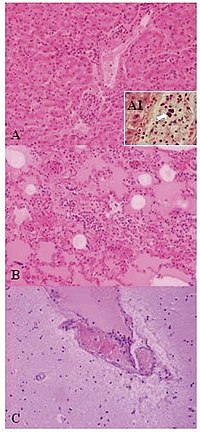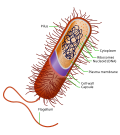bacteriology, gram-positive bacteria are bacteria that give a positive result in the Gram stain test, which is traditionally used to quickly classify bacteria into...
24 KB (2,653 words) - 14:36, 28 October 2024
Gram-negative bacteria are bacteria that, unlike gram-positive bacteria, do not retain the crystal violet stain used in the Gram staining method of bacterial...
24 KB (2,445 words) - 22:33, 4 September 2024
Gram stain (Gram staining or Gram's method), is a method of staining used to classify bacterial species into two large groups: gram-positive bacteria...
28 KB (2,836 words) - 16:33, 3 November 2024
Bacterial cellular morphologies (redirect from Gram-positive cocci)
arrangement of eight cocci such as Sarcina ventriculi. The gram-positive cocci are a large group of bacteria with similar morphology. All are spherical or nearly...
24 KB (2,335 words) - 19:10, 22 October 2024
Bacterial cell structure (redirect from Gram-positive cell wall)
bacterial cell walls, those of Gram-positive bacteria and those of Gram-negative bacteria, which are differentiated by their Gram staining characteristics....
35 KB (4,590 words) - 05:56, 9 November 2024
order of gram-positive, low-GC, acid-tolerant, generally nonsporulating, nonrespiring, either rod-shaped (bacilli) or spherical (cocci) bacteria that share...
28 KB (2,807 words) - 02:05, 9 November 2024
stoichiometry of E1:E2:E3 (monomers) = 32:24:16 In contrast, in Gram-positive bacteria (e.g. Bacillus stearothermophilus) and eukaryotes the central PDC...
29 KB (3,340 words) - 07:13, 19 November 2024
Bacilli (redirect from Gram-positive endospore-forming rods)
almost exclusively gram-positive bacteria. The name Bacillus, capitalized and italicized, refers to a specific genus of bacteria. The name Bacilli, capitalized...
23 KB (423 words) - 13:55, 13 December 2023
the total cell volume of gram-negative bacteria, but is a much smaller percentage in gram-positive bacteria. Although bacteria are conventionally divided...
20 KB (2,287 words) - 11:18, 19 July 2024
MacConkey agar (section Lac positive)
inhibits growth of gram-positive organisms with crystal violet and bile salts, allowing for the selection and isolation of gram-negative bacteria. The media detects...
7 KB (688 words) - 20:17, 18 September 2024
Bacterial capsule (redirect from Polysaccharide encapsulated bacteria)
various diseases. The capsule—which can be found in both gram negative and gram-positive bacteria—is different from the second lipid membrane – bacterial...
17 KB (1,785 words) - 22:12, 1 October 2024
Bacteriocin (section From Gram positive bacteria)
phenomenologically related. These include the bacteriocins from gram-positive bacteria, the colicins, the microcins, and the bacteriocins from Archaea...
31 KB (3,540 words) - 05:46, 11 November 2024
gram-negative bacteria and is recognized by TLR2, which is usually in a heterodimer of with TLR1 or TLR6. Lipoteichoic acid (LTA) from gram-positive bacteria...
13 KB (1,476 words) - 12:50, 13 January 2024
Atypical bacteria are bacteria that do not get colored by gram-staining but rather remain colorless: they are neither Gram-positive nor Gram-negative...
4 KB (427 words) - 20:16, 11 February 2023
Endospore (redirect from Endospore-forming bacteria)
usually triggered by a lack of nutrients, and usually occurs in gram-positive bacteria. In endospore formation, the bacterium divides within its cell wall...
28 KB (3,178 words) - 17:04, 30 October 2024
Bacillus (redirect from Bacillus (bacteria))
Bacillus (Latin "stick") is a genus of Gram-positive, rod-shaped bacteria, a member of the phylum Bacillota, with 266 named species. The term is also used...
53 KB (4,741 words) - 08:15, 13 November 2024
Quorum sensing (section Gram-positive bacteria)
changes in gene expression. Gram-positive bacteria use autoinducing peptides (AIP) as their autoinducers. When gram-positive bacteria detect high concentration...
83 KB (10,171 words) - 05:27, 18 November 2024
peptidoglycan layer is substantially thicker in gram-positive bacteria (20 to 80 nanometers) than in gram-negative bacteria (7 to 8 nanometers). Depending on pH...
36 KB (4,018 words) - 18:24, 24 September 2024
Septic shock (section Gram-positive)
cases of septic shock are caused by gram-positive bacteria, followed by endotoxin-producing gram-negative bacteria, although fungal infections are an increasingly...
32 KB (3,599 words) - 13:37, 8 September 2024
Protein targeting (section Gram-positive bacteria)
Bacteria may have a single plasma membrane (Gram-positive bacteria), or an inner membrane plus an outer membrane separated by the periplasm (Gram-negative...
53 KB (6,406 words) - 07:06, 12 November 2024
types: Bacteria can enter the bloodstream in a number of different ways. However, for each major classification of bacteria (gram negative, gram positive, or...
35 KB (3,681 words) - 09:15, 23 May 2024
relatively broad spectrum, being effective against both Gram-negative and Gram-positive bacteria. The combination is available over the counter in the US...
14 KB (1,233 words) - 03:59, 5 October 2024
Corynebacterium (redirect from Coryneform bacteria)
Corynebacterium (/kɔːˈraɪnəbækˌtɪəriəm, -ˈrɪn-/) is a genus of Gram-positive bacteria and most are aerobic. They are bacilli (rod-shaped), and in some...
54 KB (4,717 words) - 07:34, 11 November 2024
that classify bacteria into Gram-positive bacteria and Gram-negative bacteria. The names originate from the reaction of cells to the Gram stain, a long-standing...
143 KB (15,534 words) - 20:00, 8 November 2024
identification of Gram-negative bacteria, specifically the Enterobacteriaceae. EMB inhibits the growth of most Gram-positive bacteria. EMB is often used...
5 KB (430 words) - 09:42, 11 March 2024
Linezolid (section Gram-negative bacteria)
infections caused by Gram-positive bacteria that are resistant to other antibiotics. Linezolid is active against most Gram-positive bacteria that cause disease...
108 KB (10,601 words) - 21:38, 19 October 2024
and urinary tract infections caused by Klebsiella species. Some Gram-positive bacteria have developed resistance to doxycycline. Up to 44% of Streptococcus...
96 KB (9,320 words) - 19:17, 24 November 2024
Staphylococcus (redirect from Coagulase-positive staphylococci)
Staphylococcus is a genus of Gram-positive bacteria in the family Staphylococcaceae from the order Bacillales. Under the microscope, they appear spherical...
27 KB (2,812 words) - 05:51, 29 October 2024
Secretion (section In gram-positive bacteria)
cytoplasmic membrane by the twin-arginine translocation pathway (Tat). Gram-negative bacteria have two membranes, thus making secretion topologically more complex...
26 KB (2,981 words) - 11:14, 25 October 2024
Cell envelope (category Bacteria)
comprises the inner cell membrane and the cell wall of a bacterium. In Gram-negative bacteria an outer membrane is also included. This envelope is not present...
9 KB (1,169 words) - 03:12, 12 May 2024




















